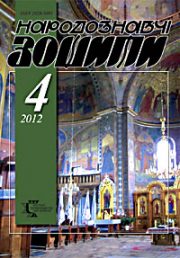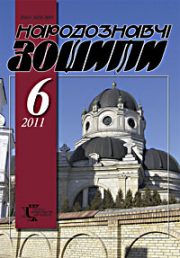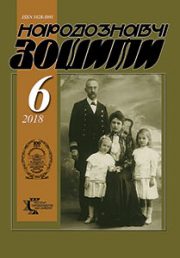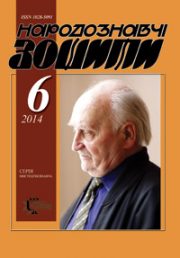2024 #1 Rakhno K.
The Ethnology Notebooks. 2024. № 1 (175), 16—29
UDK 398.3(477.74):930.25
DOI https://doi.org/10.15407/nz2024.01.016
CLAY VESSELS IN RAIN-INCALLING RITES OF UKRAINIANS AND BELARUSIANS AND TILE MAGIC OF SOUTHERN SLAVIC
RAKHNO Kostyantyn
- ORCID ID: https://orcid.org/0000-0002-0973-3919
- Doctor of History, Associate Professor,
- Leading Researcher of the National Museum of Ukrainian Pottery in Opishne,
- 102, Partyzanska Street, 38164, Opishne,
- Zinkiv District, Poltava Region, Ukraine,
- Contacts: e-mail: krakhno@ukr.net
Abstract. Drought is a natural phenomenon, surrounded by a large number of natural phenomena for the Slavs. The cause of the drought could be witchcraft, as well as the performance of actions prohibited by certain calendar dates. The most important spring and summer folk rites were closely related to the provision of heavenly moisture, on which the growth of plants and the harvest depended. At the same time, pottery products were used. The purpose of the article is to investigate certain symbolic actions with earthenware, performing which, according to popular belief, can cause or stop precipitation. The object of the study is the throwing of pots into a well, which was a common element of the rite of invoking rain in Ukraine and neighboring regions of Belarus. It is known that in magical practice it was required to use mostly stolen dishes. The pot or jug needed for the ceremony had to be stolen from a neighbor, a widow or a potter. In Ukraine, ethnographers noted cases of throwing pots filled with borscht into a well, which had the character of a sacrifice. Instead, the subject is the kinship of such rites with the opposition to the magic of potters, brick manufacturers, and tile makers in Bulgaria, Macedonia, Serbia, and Bosnia in the late 19th and early 20th centuries. These craftsmen, who worked mainly in summer, were particularly interested in clear, dry weather, and therefore resorted to magical actions to induce drought. Their essence consisted in burying a live animal in the ground, which allegedly provoked the cessation of rains. The way to neutralize this was to steal the tools or products of brick manufacturers and tile makers and throw them into the water. The methodological basis of the research is the structuralist methodological toolkit.
The basis of the work is folklore and ethnographic materials that show the ancient commonality of ideas of Eastern and Southern Slavs. The results of the research are that they highlight the mythologizing of the pottery craft, the image of the potter in Slavic mythological beliefs as a priest endowed with power over the weather, a mediator between society and higher forces, able to cause and stop atmospheric precipitation.
Keywords: invoking rain, earthenware, pottery, tile making, brickmaking, legends, rites, customs, mythology of the Slavs.
Received 23.11.2023
REFERENCES
- Svyryda, R. (2000). Give Us Rain, God! Ukrainian family: Family and Public Life (Pp. 286—289). Kyiv: publishing house named after Olena Teliga [in Ukrainian].
- Sartori, P. (1916). Theft as Magic. Swiss Archives of Folklore, 20, 380—384 [in German].
- Selivanov, A.I. (1886). Ethnographic Sketches of the Voronezh Province. Voronezh Anniversary Collection in Memory of the Tercentenary of the City of Voronezh (Vol. 2, pp. 69—116). Voronezh: typo-lithography of the Guvernorate board [in Russian].
- Romanov, Ye.R. (1912). Belarusian Collection (Issue 8: Life of a Belarusian). Vilna: A.G. Syrkin’s printing house [in Russian].
- Tolstoy, N.I., Tolstaya, S.M. (1978). Notes on Slavic Paganism. 2. Making Rain in Polissya. Slavic and Balkan Folklore: Genesis. Archaic. Traditions (Pp. 95—130). Moscow: Nauka [in Russian].
- Antropov, N.P. (2004). Belarusian Ethnolinguistic Studies: 2. Making Rain (Action Code). Language of Culture: Semantics and Grammar. To the 80th Anniversary of the Birth of Academician Nikita Ilyich Tolstoy (1923—1996) (Pp. 190—216). Moscow: Indrik [in Russian].
- Mazeiko, L.M. (1999). Agrarian Magic of Making Rain (Based on Materials from the Expedition On the Ways of Ancient Families along the Besed River from Its Source to its Confluence with the Sozh River). Ethnography of the Belarusian Transdnieper Region: Materials of the Scientific Conference November 30— December 1, 1999 (Pp. 76—80). Mogilev: Publishing House of the A.A. Kulyashov Mogilev State University [in Russian].
- Gura, A.V., Ternovskaya, O.A., & Tolstaya, S.M. (1983). Materials for the Polissya Ethnolinguistic Atlas. Polissya Ethnolinguistic Collection: Materials and Studies (Pp. 49—153). Moscow: Nauka [in Russian].
- Belova, O. (2007). Folk Magic in the Regions of Ethnocultural Contacts of the Slavs and Jews. Traditional Medicine and Magic in the Slavic and Jewish Cultural Tradition: Collection of articles (Pp. 110—136). Moscow: Center Sefer [in Russian].
- Tolstoy, N.I., & Tolstaya, S.M. (1981). Notes on Slavic Paganism. 1. Making Rain at a Well. Russian Folklore (Vol. XXI, pp. 87—98). Moscow: Nauka [in Russian].
- Skurativskyi, V. (2000). From Spiritual Treasures to the People. Berehynya, 1, 87—92 [in Ukrainian].
- Kolotylo, T. (2006). About the Drought in the Ethnic Vision of the Inhabitants of the Podillya Region. Berehynya, 3, 31—48 [in Ukrainian].
- Vorotnyak, I. (2006). Semantics of the Rituals of Meteorological Magic among the Rural Population of Bukovyna in the 19th — Early 20th Centuries. Issues of Ancient and Medieval History, Archaeology and Ethnology: Collection of Scientific Works (Vol. 1 (21), pp. 136—147). Chernivtsi: Prut [in Ukrainian].
- Lysenko, O.V., & Ostrovsky, A.B. (1990). Logical Schemes of Occasional Rain-Making Rituals in Belarusian Polissya. Paganism of the Eastern Slavs. Collection of Scientific Papers (Pp. 108—119). Leningrad: State Order of Friendship of Peoples Museum of Ethnography of the Peoples of the USSR [in Russian].
- Tyshchenko, K. (2006). Lingual Contacts: Witnesses of Formation of the Ukrainians. Kyiv: Akvilon-Plus [in Ukrainian].
- Karpov, Yu.Yu. (2001). Female Space in the Culture of the Peoples of the Caucasus. Saint Petersburg: Petersburg Oriental Studies [in Russian].
- Boneva, T. (1987). Characteristics of the People’s Professional Culture (World Outlook Grounds). Second International Congress on Bulgarian Studies. Reports. Ethnography (Vol. 10, pp. 256—268). Sofia: Publishing house at the Bulgarian Academy of Sciences [in Bulgarian].
- Arnaudov, M. (1943). Bulgarian Calendar Holidays, Customs, Beliefs, Songs and Amusements During the Whole Year. Sofia: Hemus; Knipegraf publishing house [in Bulgarian].
- Shapkarev, K. (1968). Collection of Bulgarian Folk Lore: in 4 vol. (Vol. 1: Ceremonial Songs. People Customs). Sofia: Bulgarian writer [in Bulgarian and Macedonian].
- Kepov, I.P. (1936). Ethnographical, Painting and Lingual Materials from the Village of Boboshevo-Dupnishko. The Collection of Folk Lore, Science and Book Learning (Book XLII, pp. 1—288). Sofia: State printing house [in Bulgarian].
- Arnaudov, M. (1971). Studies in Bulgarian Ceremonies and Legends (Vol. 1). Sofia: publishing house of the Bulgarian Academy on Naukite [in Bulgarian].
- Marinov, D. (1994). People’s Faith and Religious People’s Customs. Sofia: Publishing house at the Bulgarian Academy on Naukite [in Bulgarian].
- Tanovic, S. (1927). Serbian Folk Customs in Devdeliya. Serbian Ethnographic Collection (Vol. XL (16). Beograd and Zemun: Publisged by the Makarije factory [in Serbian].
- Ginchev, Ts. (1988). A Few Words about the Crafts, Herbalism and Beliefs of the Bulgarian People. Sofia: Zemizdat [in Bulgarian].
- Popov, R., & Mitseva, E. (2002). People’s Worldview. Sakar: An Ethnographic, Folkloric and Linguistic Study (Pp. 231—254). Sofia: academic publishing house Prof. Marin Drinov [in Bulgarian].
- Stamenova, Zh. (1986). Calendar Holidays and Customs. Plovdiv Region: Ethnographic and Linguistic Studies (Pp. 244—283). Sofia: Publishing House of the Bulgarian Academy of Sciences [in Bulgarian].
- Genchev, S. (1974). Customs and Rites for Rain. Dobruja. Ethnographic, Folklore and Linguistic Studies (Pp. 345—351). Sofia: Publishing House of the Bulgarian Academy of Sciences [in Bulgarian].
- Popov, R. (1996). People’s Worldview. Strandzha. Material and Spiritual Culture (Pp. 216—236). Sofia: academic publishing house Prof. Marin Drinov [in Bulgarian].
- Todorov, D. (1985). People’s Worldview. Kapanetses: Everyday Life and Culture of the Old Bulgarian Population in Northeast Bulgaria (Pp. 259—278). Sofia: Publishing House of the Bulgarian Academy of Sciences [in Bulgarian].
- Teneva, N. (2003). Rhodope Crafts. Sofia: Ethnographic Institute with Museum — BAS [in Bulgarian].
- Boneva, T. (1994). People’s worldview. Rhodopes. Traditional Folk Spiritual and Socionormative Culture (Pp. 7—50). Sofia: Ethnographic Institute with Museum at the National Academy of Sciences [in Bulgarian].
- Kovachev Y.D. (1914). Folk Astronomy and Meteorology. Collection of Folk Lore and Ethnography (Book XXX, pp. 1—85). Sofia: State printing house [in Bulgarian].
- Bonchev, N. (1884). Collection of Bulgarian Folk Songs. Varna: printing house of Kh. Kh-Dzha Ralev [in Bulgarian].
- Georgieva, I. (1983). Bulgarian Folk Mythology. Sofia: Science and Art [in Bulgarian].
- Sharlanova, V. (1999). Folk Meteorology (Folk Ideas and Beliefs about Atmospheric Phenomena). Sofia: FDK Publishing Agency for Scientific Literature [in Bulgarian].
- Trojanovic, S. (1911). Main Serbian Sacrificial Customs. Serbian Ethnographic Collection. Ethnological Materials and Discussions (Book XVII, pp. 1—239). Belgrade: printed in the state printing house of the Kingdom of Serbia [in Serbian].
- Dordevic, T.R. (1958). Nature in the Beliefs and Traditions of Our People (Book 1). Serbian Ethnographic Collection (Book LXXI). Belgrade: publishing institution of the Serbian Academy of Sciences [in Serbian].
- Milosavljevic, S.M. (1913). The Customs of the Serbian People from the Homolje Region. Serbian Ethnographic Collection (Book XIX). Belgrade: new printing house — Davidovic by Ljub. M. Davidovic [in Serbian].
- Dordevic, D.M. (1985). Folk Life and Customs in the Leskovac Region. Leskovac: Library of the National Museum in Leskovac [in Serbian].
- Vasiljevic, A. (1897). From Folk Superstitions in Svrljig. The Bosnian Vila: A Magazine for Entertainment, Education and Literature (Year 12, pp. 189). Sarajevo: Spindler and Leshner printing house [in Serbian].
- Derzhavin, N. (1898). Essays on the Life of South Russian Bulgarians. II. Beliegs (Text and translation). Ethnographic Review, 4, 113—125 [in Russian].
- Dmytruk, N. (1927). Famine in Ukraine in 1921. Ethnographic Bulletin, 4, 79—87 [in Ukrainian].
- Sokalski, B. (1899). The Sokal District in Terms of Geography, Ethnography, History and Economics. Lviv: published by Wl. Dzieduszycki, St. Bayli’s people’s printing house [in Polish].
- Gippius, A.A. (2023). The inscription on the Brick from Pereyaslavl the Ruthenian and «the Magic of Tile Makers». Word and Man: to the 100th Anniversary of the Birth of Academician Nikita Ilyich Tolstoy (Pp. 82—86). Moscow: Indryk [in Russian].
- Hrinchenko, B.D. (1895). Ethnographic Materials Collected in Chernihiv and Neighbouring Governorates (Issue 1). Chernihiv: Governorate Council printing house [in Russian].
- Popov, R. (2008). Saints and Demons in Balkans. Sofia: Letera [in Bulgarian].
- Muslea, I., Barlea, O. (1970). The Folklore Typology from the Answers to the Questionnaires of B.P. Hasdeu. Bucharest: Minerva [in Romanian].
- Gorovei, A. (1915). Beliefs and Superstitions of the Romanian People. Bucharest: Socec&Comp Bookstores, Pavel Suru, C. Stefea [in Romanian].
- Moisei, A.A. (2008). Magic and Divination in the Folk Calendar of the Eastern Romanic Population of Bukovyna. Chernivtsi: Druk Art LLC [in Ukrainian].
- Tsivyan, T.V. (1990). Linguistic Foundations of the Balkan Model of the World. Moscow: Nauka [in Russian].
- Khalilov, Kh.M. (1984). The Reflection of Paganism in the Rituals and Folklore of the Laks. Mythology of the Peoples of Dagestan (Pp. 63—81). Makhachkala: Typography of the Dagestan Branch of the Academy of Sciences of the USSR [in Russian].
- Bulatova, A.G. (1988). Traditional Holidays and Rites of the Peoples of Mountainous Dagestan in the 19th and Early 20th Centuries. Leningrad: Nauka [in Russian].
- Darchiev, A.V. (2014). On the Question of Mythological Basis of the Ossetian Legend of Sameli. Bulletin of the V.I. Abayev North-Ossetian Institute of Humanitarian and Social Studies, 14 (53), 73—78 [in Russian].
- Freidenberg, O.M. (1998). Myth and Literature of Antiquity. Moscow: Vostochnaya literatura [in Russian].
- Pindar. Bacchylides. (1980). Odes. Fragments. Moscow: Nauka [in Russian].
- Antoninus Liberalis. (1997). Metamorphoses. Bulletin of Ancient History, 4, 218—231 [in Russian].
- Losev, A. (1996). Mythology of the Greeks and Romans. Moscow: Mysl. [in Russian].
- Gubernatis, A.de. (1874). The Animals in Indo-European Mythology. Leipzig: Publishing house of F.W. Grunow [in German].
- Anichkov, E.V. (1903). Spring Ceremonial Song in the West and among the Slavs. From the Rite to the Song (Part I). Saint Petersburg: printing house of the Imperial Academy of Sciences [in Russian].
- Sveshnikova, T.N., & Tsivyan, T.V. (1979). To the Functions of Utensils in Eastern Roman Folklore. Ethnic History of Eastern Romances: Antiquity and the Middle Ages (Pp. 147—190). Moscow: Nauka [in Russian].
- Rakhno, K. (2011). The Semantics of the Pottery Kiln Fire in Belarusian Culture. Studia mythologica slavica (Vol. XIV, pp. 229—250). Ljubljana: Scientific Research Center of the Slovenian Academy of Sciences and Arts, Institute of Slovenian Ethnology, Ljubljana, Slovenia; University of Udine, Department of Languages and Civilizations of Central-Eastern Europe, Udine, Italy [in Ukrainian].
- Bobrinskiy, A. (1995). Paginal Comments on the book by O.M. Poshyvailo Ethnography of Ukrainian Pottery: Left Bank Dnieper Ukraine. Ukrainian Pottery: National Cultural Yearbook. For the year 1994 (Book 2, pp. 513—521). Opishne: Ukrainian Ethnology [in Russian].
- Zajkovsky, E.M., & Duchyts, L.U. (2001). Life-Giving Springs of Belarus. Minsk: Uradzhai [in Belarusian].
- Wegrzynowicz, T. (1982). Animal Remains as an Expression of Beliefs in the Times of Cremation. Warsaw: State Archaeological Museum [in Polish].
- Sicinski, W. (1996). Preliminary Results of the Examination of the Przeworsk Culture Settlement 1A in Zadowice, Province Kalisz. Archaeological Reports (Vol. XLVIII, pp. 135—151). Krakow: Institute of Archeology and Ethnology of the Polish Academy of Sciences [in Polish].
- Rajewski, Z., & Maciejewski, F. (1957). Excavation Studies of Water Springs in Biskupin, the Znin District. Archaeological News, XXIV, 232—243 [in Polish].
- (1841). The Complete Collection of Russian Chronicles. Novgorod Chronicles (Vol. III). Saint Petersburg: Eduard Prats printing house [in Russian].
- (1851). The Complete Collection of Russian Chronicles. Pskov and Sofia Chronicles (Vol. V). Saint Petersburg: Eduard Prats printing house [in Russian].
- (1965). The Complete Collection of Russian Chronicles. Rogozhskoye chronicler. Tver Collection (Vol. XV, issue 1). Moscow: Nauka [in Russian].
- (1949). The Complete Collection of Russian Chronicles. Moscow Chronicle Compilation of the Late 15th Century (Vol. XXV). Moscow; Leningrad: Publishing House of the Academy of Sciences of the USSR [in Russian].
- (1977). The Complete Collection of Russian Chronicles. Kholmogory Chronicle. The Chronicler of Dvina (Vol. XXXIII). Leningrad: Nauka [in Russian].
- Girard, R. (2000). Violence and the Sacred. Moscow: New Literary Review [in Russian].
- Caillois, R. (2003). Myth and Man. Man and the Sacred. Moscow: United Humanitarian Publishing House [in Russian].
- Saraswati, B. (1979). Pottery-Making Cultures and Indian Civilization. New Delhi: Abhinav Publications.







